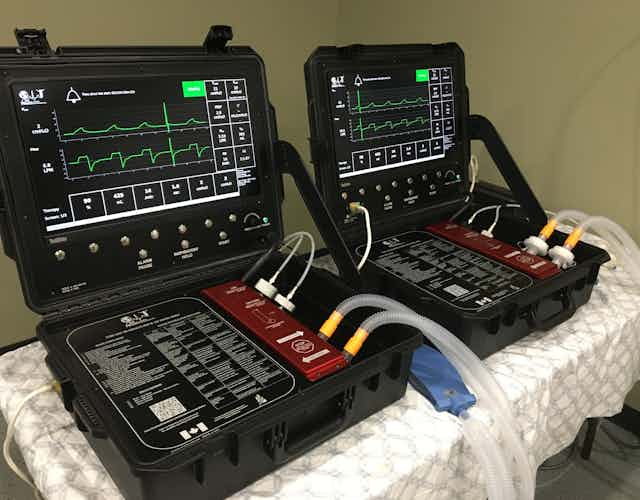The University of Saskatchewan’s aspirations to be “the university the world needs” took on tangible meaning in response to the COVID-19 pandemic. For our colleagues who are health-care professionals or researchers in the areas of infectious diseases and vaccine development, their contributions to the pandemic response were readily apparent. What about a veterinarian and a lawyer?
In March 2020, we — a vet and a lawyer — each faced disruptions to our sabbatical plans. Instead, we found an opportunity to apply our expertise in comparative science, law and One Health research to a local COVID-19 project. We worked collaboratively with One Health Medical Technologies, a Saskatoon-based company that designed and built an emergency-use ventilator (EUV-SK1), now certified by Health Canada.
The project and its main challenges
The pandemic has highlighted an over-reliance on the global supply chain. In addition to the increased demand in masks and other personal protective equipment, medical devices and supplies for diagnostic testing, the main reason for the shortages were outsourced production and the need to ship supplies and equipment all over the world during a global lockdown. A marked decline in Canada’s manufacturing sector had put Canadians at risk, yet the barriers of entry into medical device manufacturing are steep.
The medical device industry is extensively regulated. Each country has its own regulations that need to be met before a medical device can enter the market. In Canada, Health Canada makes those determinations.

Each step involved in bringing a medical device from concept to completion — including design, material selection, building and testing a prototype and third-party testing — is heavily regulated. Patient safety and risk mitigation are governing principles.
In response to the increased global demand for ventilators and other medical supplies, Health Canada released an interim order to temporarily accelerate this process that created space for new manufacturers to enter the market.
An interdisciplinary local team effort
Finding solutions to the challenges of human movement restrictions, business closures and supply shortages were some of the main principles applied in this project initiated and led by One Health Medical Technologies (part of the RMD Group of companies), which resulted in the EUV-SK1. Reducing the number of moving parts inside the ventilator, relying on in-house production capacity and capability, as well as partnering with local experts from the Saskatchewan Health Authority and USask, helped to make the EUV-SK1 a reality.
The user-friendliness of a medical device is directly linked to patient safety, so a respiratory therapist and an intensive care nurse were integral parts of the project from the beginning. Further subject matter expertise was contributed from the University of Saskatchewan’s college of medicine, its respiratory research centre and the college of engineering.
Every stage of medical device design and manufacturing is governed by standards. Standards further dictate how and under which conditions the device must function. The latter is verified through third-party testing.
Academics adding value in the ‘real world’
Following the standards and government regulations is essential on the path to medical device authorization. That’s why the project needed a law professor: I (Patricia) assisted the engineers, designers, programmers and tradespeople involved in the project with understanding what those requirements were, and helped them communicate how they had ensured that the EUV-SK1 met those requirements in the Health Canada submission.

Every medical device needs to be accompanied by instructions for use and training resources. This is where the project required a veterinarian’s skill set.
As a faculty member from the Western College of Veterinary Medicine, I (Julia) led the team that put together the ventilator’s operation manual and training resources for health-care professionals. My research and clinical interests include lung disease in horses. I applied my background as a teacher and clinician scientist to the instructions and training manual, as well as to designing and organizing the pre-market performance and usability testing of the ventilator, using a commercially available breathing simulator.
Usability testing is important because it prevents errors in use and ensures patient safety. Test lung parameters and ventilator settings are provided by an international standard for safety and performance testing of ventilators (ISO 80601-2-80). Results of performance testing show the accuracy of the ventilator, which is then included in the instructions.
This project illustrates how academics can readily pivot and apply their skill set within a broader context when needed. This gave us the unique opportunity to work with an innovative, talented and diverse group of people on a made-in-Saskatchewan project.

